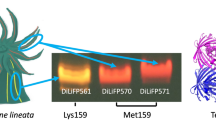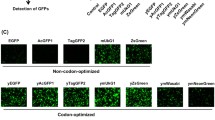Abstract
The bioluminescent systems of many marine organisms are comprised of two proteins—the Ca2+-regulated photoprotein and green-fluorescent protein (GFP). This work reports the cloning of the full-size cDNA encoding GFP (cgreGFP) from jellyfish Clytia gregaria, its expression and properties of the recombinant protein. The overall degree of identity between the amino acid sequence of the novel cgreGFP and the sequence of GFP (avGFP) from Aequorea victoria is 42% (similarity–64%) despite these GFPs originating from jellyfish that both belong to the same class, Hydrozoa. However although the degree of identity is low, three residues, Ser-Tyr-Gly, which form the chromophore are identical in both GFPs. The cgreGFP displayed two absorption peaks at 278 and 485 nm, and the fluorescence maximum at 500 nm. The fluorescence quantum yield was determined to be 0.86, the brightness to be 54 mM−1 cm−1. For the first time we have also demonstrated an efficient radiationless energy transfer in vitro between clytin and cgreGFP in solution at micromolar concentrations. The cgreGFP may be a useful intracellular fluorescent marker, as it was able to be expressed in mammalian cells.
Similar content being viewed by others
References
O. Shimomura, Bioluminescence: Chemical Principles and Methods, World Scientific Publishing Co., Singapore, 2006.
O. Shimomura, F. H. Johnson and Y. Saiga, Extraction, purification and properties of aequorin, a bioluminescent protein from the luminous hydromedusan, Aequorea, J. Cell. Comp. Physiol., 1962, 59, 223–239.
D. G. Allen, J. R. Blinks and F. G. Prendergast, Aequorin luminescence: relation of light emission to calcium concentration–a calcium-independent component, Science, 1977, 195, 996–998.
O. Shimomura and F. H. Johnson, Structure of the light-emitting moiety of aequorin, Biochemistry, 1972, 11, 1602–1608.
M. J. Cormier, K. Hori, Y. D. Karkhanis, J. M. Anderson, J. E. Wampler, J. G. Morin and J. W. Hastings, Evidence for similar biochemical requirements for bioluminescence among the coelenterates, J. Cell. Physiol., 1973, 81, 291–297.
E. S. Vysotski and J. Lee, Ca2+-regulated photoproteins: structural insight into the bioluminescence mechanism, Acc. Chem. Res., 2004, 37, 405–415.
J. G. Morin, in Coelenterate Biology: Reviews and New Perspectives, ed. L. Muscatine and H. M. Lenhoff, Academic Press, New York, 1974, pp. 397–438
J. G. Morin and J. W. Hastings, Energy transfer in a bioluminescent system, J. Cell. Physiol., 1971, 77, 313–318.
M. J. Cormier, in Bioluminescence in Action, ed. P. J. Herring, Academic Press, London, 1978, pp. 75–108
W. W. Ward, in Photochemical and Photobiological Reviews, ed. K. C. Smith, Plenum Press, New York, 1979, Vol. 4, pp. 1–57
P. J. Herring, The spectral characteristics of luminous marine organisms, Proc. R. Soc. London, Ser. B, 1983, 220, 183–217.
D. C. Prasher, V. K. Eckenrode, W. W. Ward, F. G. Prendergast and M. J. Cormier, Primary structure of the Aequorea victoria green-fluorescent protein, Gene, 1992, 111, 229–233.
N. S. Xia, W. X. Luo, J. Zhang, X. Y. Xie, H. J. Yang, S. W. Li, M. Chen and M. H. Ng, Bioluminescence of Aequorea macrodactyla, a common jellyfish species in the East China Sea, Mar. Biotechnol., 2002, 4, 155–162.
N. G. Gurskaya, A. F. Fradkov, N. I. Pounkova, D. B. Staroverov, M. E. Bulina, Y. G. Yanushevich, Y. A. Labas, S. Lukyanov and K. A. Lukyanov, A colorless green fluorescent protein homologue from the non-fluorescent hydromedusa Aequorea coerulescens and its fluorescent mutants, Biochem. J., 2003, 373, 403–408.
R. Y. Tsien, The green fluorescent protein, Annu. Rev. Biochem., 1998, 67, 509–544.
R. Y. Tsien, Creating new fluorescent probes for cell biology, Nat. Rev. Mol. Cell Biol., 2002, 3, 906–918.
Y. A. Labas, N. G. Gurskaya, Y. G. Yanushevich, A. F. Fradkov, K. A. Lukyanov, S. A. Lukyanov and M. V. Matz, Diversity and evolution of the green fluorescent protein family, Proc. Natl. Acad. Sci. U. S. A., 2002, 99, 4256–4261.
S. Inouye and F. I. Tsuji, Cloning and sequence analysis of cDNA for the Ca2+-activated photoprotein, clytin, FEBS Lett., 1993, 315, 343–346.
S. Inouye, Cloning, expression, purification and characterization of an isotype of clytin, a calcium-binding photoprotein from the luminous hydromedusa Clytia gregarium, J. Biochem., 2008, 143, 711–717.
W. W. Ward and M. J. Cormier, In vitro energy transfer in Renilla bioluminescence, J. Phys. Chem., 1976, 80, 2289–2291.
W. W. Ward and M. J. Cormier, Energy transfer via protein-protein interaction in Renilla bioluminescence, Photochem. Photobiol., 1978, 27, 389–396.
W. W. Ward and M. J. Cormier, An energy transfer protein in coelenterate bioluminescence. Characterization of the Renilla green fluorescent protein, J. Biol. Chem., 1979, 254, 781–788.
S. V. Markova, E. S. Vysotski and J. Lee, in Bioluminescence and Chemiluminescence 2000, ed. J. F. Case, P. J. Herring, B. H. Robison, S. H. D. Haddock, L. J. Kricka and P. E. Stanley, World Scientific, Singapore, 2001, pp. 115–118
B. A. Illarionov, L. A. Frank, V. A. Illarionova, V. S. Bondar, E. S. Vysotski and J. R. Blinks, Recombinant obelin: cloning and expression of cDNA, purification and characterization as a calcium indicator, Methods Enzymol., 2000, 305, 223–249.
E. S. Vysotski, Z. J. Liu, J. Rose, B. C. Wang and J. Lee, Preparation and X-ray crystallographic analysis of recombinant obelin crystals diffracting to beyond 1.1 Å, Acta Crystallogr., Sect. D: Biol. Crystallogr., 2001, 57, 1919–1921.
M. E. Gasparian, V. G. Ostapchenko, A. A. Schulga, D. A. Dolgih and M. P. Kirpichikov, Expression, purification, and characterization of human enteropeptidase catalytic subunit in Escherichia coli, Protein Expression Purif., 2003, 31, 133–139.
G. R. Fleming, A. W. E. Knight, J. M. Morris, R. J. S. Morrison and G. W. Robinson, Picosecond fluorescence studies of xanthene dyes, J. Am. Chem. Soc., 1977, 99, 4306–4311.
J. R. Lakowicz, Principles of Fluorescence Spectroscopy, Third Edition, Springer, Singapore, 2006.
N. C. Shaner, P. A. Steinbach and R. Y. Tsien, A guide to choosing fluorescent proteins, Nat. Methods, 2005, 2, 905–909.
E. M. Phizicky and S. Fields, Protein-protein interactions: Methods for detection and analysis, Microbiol. Rev., 1995, 59, 94–123.
J. Sambrook, E. F. Fritsch and T. Maniatis, Molecular Cloning: A Laboratory Manual, 2nd edn, Cold Spring Harbor Laboratory Press, NY, 1989.
T. A. Brown, Essential Molecular Biology I: A Practical Approach Series, IRL Press, Oxford, 1990.
S. Inouye, M. Noguchi, Y. Sakaki, Y. Takagi, T. Miyata, S. Iwanaga, T. Miyata and F. I. Tsuji, Cloning and sequence analysis of cDNA for the luminescent protein aequorin, Proc. Natl. Acad. Sci. U. S. A., 1985, 82, 3154–3158.
D. C. Prasher, R. O. McCann, M. Longiaru and M. J. Cormier, Sequence comparisons of complementary DNAs encoding aequorin isotypes, Biochemistry, 1987, 26, 1326–1332.
O. Shimomura, Isolation and properties of various molecular forms of aequorin, Biochem. J., 1986, 234, 271–277.
S. V. Markova, E. S. Vysotski, J. R. Blinks, L. P. Burakova, B. C. Wang and J. Lee, Obelin from the bioluminescent marine hydroid Obelia geniculata: cloning, expression, and comparison of some properties with those of other Ca2+-regulated photoproteins, Biochemistry, 2002, 41, 2227–2236.
S. Inouye and Y. Sahara, Expression, purification and characterization of a photoprotein, clytin, from Clytia gregarium, Protein Expression Purif., 2007, 53, 384–389.
L. D. Levine and W. W. Ward, Isolation and characterization of a photoprotein “phialidin”, and a spectrally unique green-fluorescent protein from the bioluminescent jellyfish Phialidium gregarium, Comp. Biochem. Physiol, 1982, 72B, 77–85.
M. Chattoraj, B. A. King, G. U. Bublitz and S. G. Boxer, Ultra-fast excited state dynamics in green fluorescent protein: multiple states and proton transfer, Proc. Natl. Acad. Sci. U. S. A., 1996, 93, 8362–8367.
J. F. Head, S. Inouye, K. Teranishi and O. Shimomura, The crystal structure of the photoprotein aequorin at 2.3 Å resolution, Nature, 2000, 405, 372–376.
Z. J. Liu, E. S. Vysotski, C. J. Chen, J. P. Rose, J. Lee and B. C. Wang, Structure of the Ca2+-regulated photoprotein obelin at 1.7Å resolution determined directly from its sulfur substructure, Protein Sci., 2000, 9, 2085–2093.
Z. J. Liu, G. A. Stepanyuk, E. S. Vysotski, J. Lee, S. V. Markova, N. P. Malikova and B. C. Wang, Crystal structure of obelin after Ca2+-triggered bioluminescence suggests neutral coelenteramide as the primary excited state, Proc. Natl. Acad. Sci. U. S. A., 2006, 103, 2570–2575.
Author information
Authors and Affiliations
Corresponding author
Additional information
Electronic supplementary information (ESI) available: Fig. S1, S2, and S3. See DOI: 10.1039/c0pp00023j
Rights and permissions
About this article
Cite this article
Markova, S.V., Burakova, L.P., Frank, L.A. et al. Green-fluorescent protein from the bioluminescent jellyfish Clytia gregaria: cDNA cloning, expression, and characterization of novel recombinant protein. Photochem Photobiol Sci 9, 757–765 (2010). https://doi.org/10.1039/c0pp00023j
Received:
Accepted:
Published:
Issue Date:
DOI: https://doi.org/10.1039/c0pp00023j




